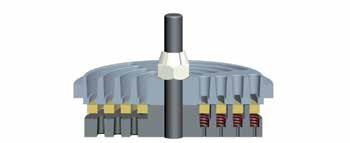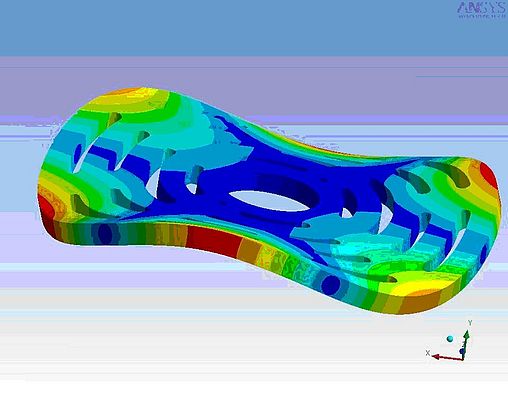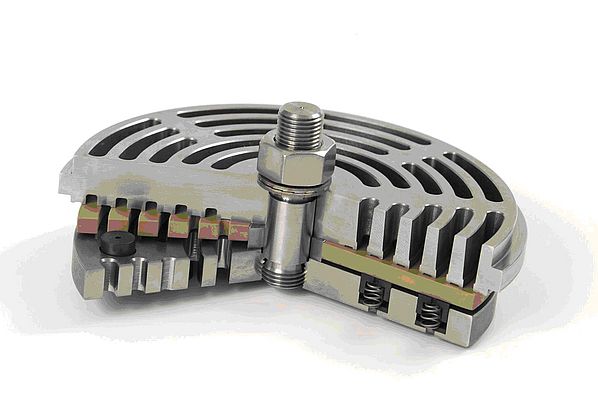Authors: Enzo Giacomelli, Consultant Engineer, and Claudio Vaglini, Customer Support Engineer
Reciprocating compressors are used in many services for Oil & Gas, with special process requirements. The range of capacities, operating conditions and molecular weights make the use of such machines very flexible. There is a continuing focus to improve operation, maintenance and consequently the availability of the plants that implies guidelines and precautions to be considered since the first design of the machines. That is important for the cylinders valves (Fig.1) as they are one of the most critical part in a compressor.
Targeting Valves Reliability
The proper selection of technologies and design procedures helps for an optimization of mechanical behaviour, a minimum energy consumption, in compliance with the specifications, to cover the requirements.
In refinery, chemical, petrochemical, natural gas and other industrial plants the operating conditions are different as a function of the applications. The pressures can reach 350Mpa for LDPE production and molecular weights are very variable. Reciprocating compressors cylinders are lubricated but dry applications are also required to avoid pollution of the product. The presence of dirt and liquids entrained by gas influences the actual operation. In refinery H2 production process have different degrees of cleanliness. For heavy duty services it is necessary a wide capacity control of the compressor to adapt the operating conditions according to process requirements.
The valve can be of different types like disk, ring type, poppet, with flat surface or special profiles. Metallic shutters have been replaced by plastic components, apart of low temperatures or very high pressures, due to the great adaptability to non controllable conditions (dirty or liquid presence). The materials of the valves for heavy duty applications in Oil & Gas are subject to requirements API 618, additional specifications of Engineering Companies and end users.
Design Modeling and Simulation
Valves design related to mechanical and fluid-dynamic aspects, affecting the reliability of the machines, needs advanced methods, simulations, technologies, high material quality.
Mathematical models are able to describe the pressure drop through the valves and the plate motion in operation. The shutters are subjected to the forces due to spring, fluid drag, inertia and damping. Many parameters are involved and the main input data are cylinder geometry, properties of gas (Molecular weight, Cp/Cv ratio), RPM, suction, discharge temperature and pressure. The outputs are plate movement, compression cycle, power loss at the valve, total power absorbed by the compressor, pressure pulsations in plenum chambers, nozzles, dampeners and piping.
The lift is calculated for an adequate gas velocity, with consequent evaluation of pressure drop and spring load, to compromise between energy saving and valve mechanical behaviour.
Excessive fluttering may cause a reduction of the life of springs, with consequent problems to the plates. For refinery applications, the gas velocity is normally higher due to the small lift required, as the drag force on the rings is low due to the low MW of the gas.
The life of the valves is greatly influenced by the movement of plate that should reach the guard and keep the position till the closure starts, with the condition to occur before the dead point. During the opening period the fluttering should be minimised to reduce the fatigue effect on the springs and multiple shock against the seat.
The valves are to withstand the operating conditions, environmental and dynamic aspects, considering the corrosion, particularly for rings and springs, undergoing fatigue stresses. FEM (Finite Elements Method) is used for strength determination of bodies, plates and for the natural frequency analysis (Fig.2).
The fluid-dynamic aspects are investigated with CFD (Computerized Fluid Dynamics) to optimize the development of standard series of valves.
Monitoring and Diagnostics
The instruments to control process parameters, such as temperature and pressure in suction and discharge help to evidence abnormalities. In addition the temperature of the cover surface can be measured to verify the correct performance of the valves.
Monitoring and Diagnostics systems anticipate problems and eliminate most of the risks. Failures affect operation and safety of personnel. In addition, they determine equipment damages and production losses.
In a multistage compressor the inter-stage pressure variations are a further help to give an identification of the origin of the problems.
The control of valve performance is made with the analysis of thermodynamic parameters, with acoustic emission analysis and in more detailed way by measuring the compression cycle and the pressure upstream and downstream the valves. Suitable instrumentation can be used for spot analysis or continuously with on-line monitoring.
The malfunction of the valves can be predicted and the most suitable period selected for replacement, possibly combined with other maintenance activities, thus reducing the risk of shutdown of the plant and increasing the availability.
Maintenance and Service
The strategies of Preventive, Predictive or Proactive Maintenance depend on the type of machines, criticality of the service and on the possibility to count on "condition monitoring" or "diagnostic systems".
Machines and valves should restore the original performance (MTBF) and keep the time for maintenance at the minimum, as directly affecting the availability of plants.
Therefore to reduce the MTTR is necessary to:
- replace immediately a valve with a spare
- combine these interventions with other possible needs to stop the machine
- plan the activities with a general shut-down
Valves can run smoothly with very good results, by reaching operating life of about 3 years or more depending on the applications. The presence of dirt, liquid or other things in the gas are worsening the operation.
Experts of valves and compressors give Engineering Support, Reconditioning and Upgrades and a more prompt solution to the ongoing operation deviations.
High Quality valves are necessary to reach good performance and a longer MTBF (Mean Time Between Failure), with consequent reduction of maintenance interventions in heavy duty applications.
The valves are reconditioned by replacing the internal parts (rings and springs), by the workshop of the plant or by external service shops. The reconditioning has to be carried out by qualified personnel, respecting strict repair and reconditioning procedures to have valve components of excellent quality and as new.
R&D can improve valve life, reducing maintenance costs and increasing the availability in case of dirty gas. Special plastic plugs avoid the relative movement between metallic parts (Fig.3), avoiding wear of counter-seats and springs.



















